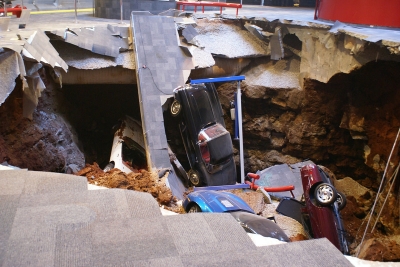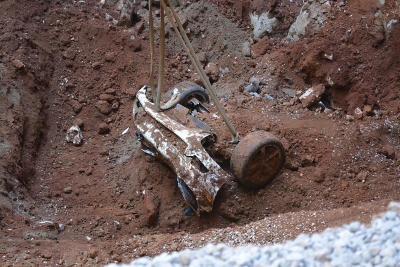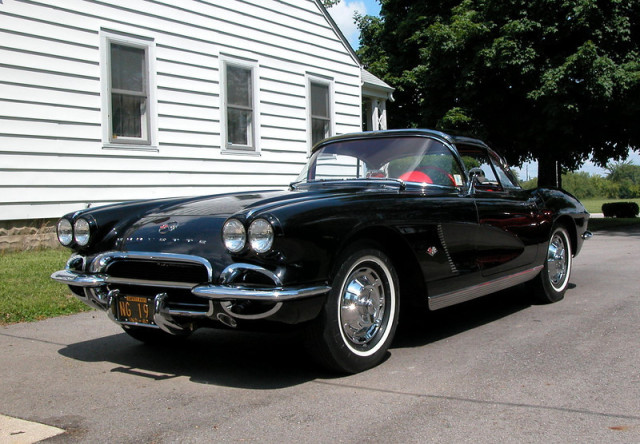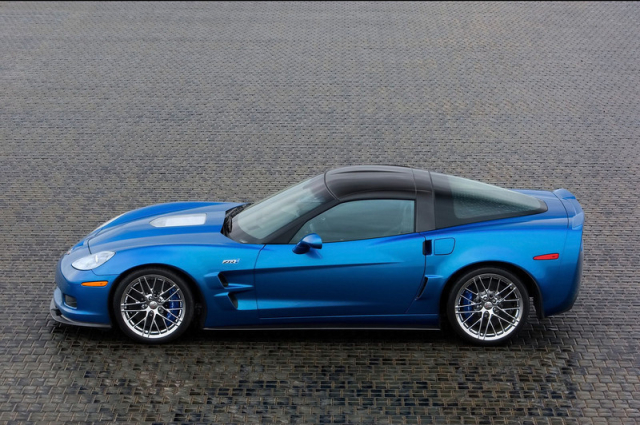 It has been over nine months since the National Corvette Museum in Bowling Green, Kentucky was rocked by an unexpected sinkhole, but as fall gets underway the famed automotive museum, dedicated to one of the world’s favorite Chevys, is still recovering.
It has been over nine months since the National Corvette Museum in Bowling Green, Kentucky was rocked by an unexpected sinkhole, but as fall gets underway the famed automotive museum, dedicated to one of the world’s favorite Chevys, is still recovering.
Luckily, recent discussions between GM and museum staff have resulted in a plan, not only to repair the damages done to the NCM’s Skydome exhibit area but also to restore a number of Corvettes damaged in the unfortunate incident. Let’s take a look at what the NCM is up against and how it plans to recover as much as they can from the gaping hole that opened in its floor on February 12th.
A Look Back at February 12th, 2014

Images: National Corvette Museum
It was the wee hours of the morning in Bowling Green, KY when alarms started sounding at the National Corvette Museum. Evidently, the museum’s motion detectors had been tripped by something, but investigators didn’t know what until they entered the Skydome exhibit area off the museum’s East side.
As it turns out, a massive sinkhole had opened up in the famed Skydome, home of the Corvette Hall of Fame and plenty of irreplaceable Corvettes, swallowing eight very special cars and causing unthinkable damage to the show floor. All of this was caught on the museum’s security footage.
When the hole was first discovered, only a couple of the affected cars could be seen, leaving imaginations to run wild in regards to the condition of over half of the “Sinkhole Eight.” With nearly a 60-foot deep hole, which stretched about 40-feet across the middle of the Skydome floor, fears of irreversible damage to some of the industry’s most significant Corvettes ensued.

 Over the days that followed, testing was done to ensure that another sinkhole would not open up in the area and that workers, which would be using heavy equipment to unearth the Corvettes in the sinkhole, would not be in danger.
Over the days that followed, testing was done to ensure that another sinkhole would not open up in the area and that workers, which would be using heavy equipment to unearth the Corvettes in the sinkhole, would not be in danger.
The extraction plan for the cars was dubbed “Operation Corvette Plus” and was given the go-ahead by engineers on February 26th.
The following week, on March 3rd, the first round of Operation Corvette Plus was underway, with workers extracting the first of the eight Corvettes from the sinkhole.
While ensuring the stability surrounding the sinkhole was an immediate must, the museum’s primary concern remained over the condition of the eight prized Corvettes that had been swallowed by the sinkhole and plans to recover them from the depths of the gaping hole.
Six of the Corvettes damaged by the sinkhole incident were owned by the NCM, while two were on loan from General Motors. The Corvettes owned by the museum and affected by the sinkhole incident are as follows.
 1) 40th Anniversary Ruby Red Corvette
1) 40th Anniversary Ruby Red Corvette
This 1993 Corvette is one of just 6,749 40th Anniversary Edition Corvettes built. Nicknamed “Ruby,” it was initially a 50th birthday gift for Hill Clark of Bay Village, OH from his wife Karen before the two donated it to the museum as a historic piece.

Image: Hemmings Daily
2) 1984 Corvette Pace Car
This unique Corvette pace car was actually a concept vehicle designed by PPG in cooperation with the Chevy Division of GM and was alternated with other pace cars to pace PPG Indy Car World Series events. Features of the Corvette included a Katech 401 ci V8 engine good for 450 hp, Warner T-5 five-speed transmission with modified overdrive, a performance suspension, George Foller chassis, Diversified Glass Products body, and a Deltron Acrylic Urethane Orange Glow Candy paint job. Assembled by Triad Service Inc., the car was one of the original exhibit cars when the NCM opened in September of 1994.
 3) The 1992 “One Millionth Corvette”
3) The 1992 “One Millionth Corvette”
An example of the Corvette model’s incredible success, this C4 Corvette is the millionth car to come off of the model’s assembly line. Built on July 2nd, 1992, it was styled like the very first ’53 Corvette with a white exterior paint scheme and red interior. Unlike its ancestor, however, it featured modern technology (for the time), including a 5.7-liter LT1 V8 engine with multi-port fuel injection, a four-speed automatic transmission, four-wheel anti-lock brakes, acceleration slip regulation, four-wheel independent suspension, five-link IRS, uni-frame construction, a pass-key theft deterrent system, and a driver’s side airbag. The car was donated to the museum by GM shortly after it was manufactured.
The One Millionth Corvette was the fourth car to be recovered from the sinkhole, revealing minor damage to the front end and a collapsed front windshield.
4) The 2009 “1.5 Millionth Corvette”
Built on May 28th, 2009, this C6 Corvette is yet another example of the Corvette’s success, skyrocketing sales numbers, and is referred to as the millionth and a half Corvette to ever be produced by GM.
 It featured a 3LT Preferred Equipment Group-power convertible top, custom leather wrapped interior, adjustable six-way heated sport bucket seats, Bluetooth capabilities, side impact airbags, a heads-up display, Bose seven-speaker stereo system with AM/FM and six-disc CD changer, and the Z51 Performance Package, which included a 6.2-liter V8 engine good for 430 hp, cross-drilled brake rotors, performance-tuned stabilizer bars, springs, shocks, and performance gear ratios.
It featured a 3LT Preferred Equipment Group-power convertible top, custom leather wrapped interior, adjustable six-way heated sport bucket seats, Bluetooth capabilities, side impact airbags, a heads-up display, Bose seven-speaker stereo system with AM/FM and six-disc CD changer, and the Z51 Performance Package, which included a 6.2-liter V8 engine good for 430 hp, cross-drilled brake rotors, performance-tuned stabilizer bars, springs, shocks, and performance gear ratios.
Other options added to the car included a six-speed paddle shift transmission, dual mode performance exhaust, forged chrome aluminum wheels, DVD navigation, an Arctic White paint scheme with a black top and red interior in honor of the first 300 Corvettes built in 1953. While the millionth Corvette was donated by GM to the museum, this legendary car was purchased by the NCM Foundation for the museum.
 The whereabouts of this particular car were initially unknown when a number of the Corvettes began to be unearthed, but was discovered in shambles upon the extraction of the GM-owned ZR-1 Spyder. With its frame and only the front fascia still intact, the car emerged from the hole looking as if it had a run-in with a scrapyard car crusher.
The whereabouts of this particular car were initially unknown when a number of the Corvettes began to be unearthed, but was discovered in shambles upon the extraction of the GM-owned ZR-1 Spyder. With its frame and only the front fascia still intact, the car emerged from the hole looking as if it had a run-in with a scrapyard car crusher.
 5) 2001 Mallett Hammer Z06 Corvette
5) 2001 Mallett Hammer Z06 Corvette
This is number 009 of the Mallett Hammer performance and aesthetic conversions completed in 2002. This Corvette is extremely unique thanks to its one-off features and performance numbers, but there’s more big names associated with it.
In fact, it is one of one AntiVenom LSX Performance AV436 conversions completed in 2008, which means it features an AntiVenom performance-tuned LSX engine good for 700 hp and 575 lb-ft of torque at the flywheel, versus the car’s original 385 hp engine; performance tuned for 475 hp through the Mallett Hammer Conversion.
 Performance figures on this particular model include a 178 mph (on radar) top speed at a one-mile top speed event (GPS indicated that the car was actually traveling at 181 mph at the one-mile mark). In its prime, the car also laid down a 10.6-second quarter mile at 128 mph.
Performance figures on this particular model include a 178 mph (on radar) top speed at a one-mile top speed event (GPS indicated that the car was actually traveling at 181 mph at the one-mile mark). In its prime, the car also laid down a 10.6-second quarter mile at 128 mph.
With just 16,000 miles on the odometer, the car was donated by lifetime members Kevin & Linda Helmintoller of Land O’ Lakes, FL when Helmintoller decided to add a new C7 Corvette to his already extensive collection of Vettes. The Helmintoller’s donated the car in hopes that it would be used for driver training or hot laps on the NCM’s new Motorsports Park track.
Upon hearing that the car was damaged in the sinkhole incident, the Helmintollers traveled to the NCM to view its recovery.
As the first car to be swallowed by the sinkhole, the Mallett Hammer Corvette was the last to be recovered. Completely mangled with no body panels left on its frame to speak of and barely enough metal to hold it together, the Mallett Hammer car was virtually unrecognizable when it was brought to the surface of the sinkhole, making it the most damaged vehicle of the Sinkhole Eight.
 6) 1962 Tuxedo Black Convertible
6) 1962 Tuxedo Black Convertible
Purchased new by David Donoho of Zionsville, IN while still in high school, this C1 Corvette is a classic one-owner car. One of 14,531 produced, all of which were convertibles, the Corvette is finished in Tuxedo Black and features a hardtop conversion carried out by Donoho. As a 1962 model, the car is of the last year for the Corvette’s conventional trunk design, which didn’t reappear until 1998. External storage access reappeared on the Corvette model in 1982 as a hatchback design but not as a trunk until 16 years later.
 Garage-kept like the other three Corvettes Donoho owned over his lifetime, the car was donated to the museum specifically so it would be well maintained in the future like it was under Donoho’s care.
Garage-kept like the other three Corvettes Donoho owned over his lifetime, the car was donated to the museum specifically so it would be well maintained in the future like it was under Donoho’s care.
This car was recovered third from the sinkhole with very little damage considering the circumstances, with the front end of the car affected most.
The remaining two Corvettes were not owned by the National Corvette Museum, but rather on loan from General Motors. These cars included the following: 7) The 2009 “Blue Devil” ZR1
7) The 2009 “Blue Devil” ZR1
Originally a 2008 Z06, this car was converted to a ’09 ZR1 by General motors. Upon its debut as the car in early ZR1 press photos, the car was nicknamed the “Blue Devil” by the media and the name stuck.
The car features an experimental VIN: 1G1YY26EX850022EK and is the sister car to VIN: 23EK Z06/Z07 which ran at Nurburgring. As the first C6 ZR1, it was the most powerful car produced by GM at the time with 638 hp and a top speed of over 200 mph.
Produced at Bowling Green, this particular car was a concept vehicle as GM never produced any ZR-1 convertibles for public sale. Featuring signatures of those involved on the underside of the rear deck lid and hood, the car is a stock 1990 ZR-1 that was produced as a convertible by GM as the first concept car ever produced on a production assembly line, according to a 1991 Vette Magazine article.
 Unique features of the Spyder include a one-off deck lid, accented exhaust tips and brake calipers, four-point racing harness, hood and front quarter panel vents for engine cooling, aero bars integrated into the body behind the seats, lowered windshield and side glass, custom billet aluminum wheels, a custom tonnau cover with a “waterfall” design, and a center high-mount stop lamp under the fuel filler door which rises when the brakes are pressed.
Unique features of the Spyder include a one-off deck lid, accented exhaust tips and brake calipers, four-point racing harness, hood and front quarter panel vents for engine cooling, aero bars integrated into the body behind the seats, lowered windshield and side glass, custom billet aluminum wheels, a custom tonnau cover with a “waterfall” design, and a center high-mount stop lamp under the fuel filler door which rises when the brakes are pressed.
Debuted at the 1991 North American Auto Show, the car was originally Sebring Silver with a Neutrino Yellow interior and was used by GM to show off the model at various shows and events. The car was later converted to a black and red color scheme.
 As one of the first Corvettes to be swallowed by the sinkhole, the ’91 ZR-1 was not immediately visible upon discovery of the hole. It took removal of much of the dirt and debris in the sinkhole to unearth the ’84 Pace Car, which was eventually discovered by its only visible body panel- the left rear quarter. Because it was so buried, damage to the car was significant, with its top half and front end nearly dissolved and interior totaled.
As one of the first Corvettes to be swallowed by the sinkhole, the ’91 ZR-1 was not immediately visible upon discovery of the hole. It took removal of much of the dirt and debris in the sinkhole to unearth the ’84 Pace Car, which was eventually discovered by its only visible body panel- the left rear quarter. Because it was so buried, damage to the car was significant, with its top half and front end nearly dissolved and interior totaled.
Since the sinkhole opened up in the Skydome on February 12th, the recovery process has been strenuous. Each Corvette was extracted from the hole, with the last and most buried car (the Mallett Hammer Corvette) removed on April 9th. Since their recovery, all eight Corvettes have been on display in their various damaged conditions in a special sinkhole exhibit at the museum. The exhibit will remain open through the Vets N’ Vettes event, set to be held the first week of November.
 The museum initially wanted to preserve at least a portion of the sinkhole and make it a permanent part of the museum, but additional safety features and necessary vapor barriers were just a few factors that added to a $1 million price tag to make that possible.
The museum initially wanted to preserve at least a portion of the sinkhole and make it a permanent part of the museum, but additional safety features and necessary vapor barriers were just a few factors that added to a $1 million price tag to make that possible.
After considering the cost, visible safety features that would be needed to stabilize the sinkhole and possible future maintenance issues if the hole remained open, the NCM Board of Directors decided to have the hole filled in. This will start happening sometime after the November Vets N’ Vettes event.
 As far as the restoration of the cars goes, it’s a delicate process. Only three of the eight Corvettes damaged in the sinkhole incident- the 2009 “Blue Devil” ZR1, the 1992 “One Millionth Corvette” and the 1962 Tuxedo Black convertible- will be restored.The
As far as the restoration of the cars goes, it’s a delicate process. Only three of the eight Corvettes damaged in the sinkhole incident- the 2009 “Blue Devil” ZR1, the 1992 “One Millionth Corvette” and the 1962 Tuxedo Black convertible- will be restored.The
GM Heritage Center will be overseeing the restoration of the ZR1 and the One Millionth Corvette while the National Corvette Museum handles the restoration of the ’62 with funding from Chevrolet. General Motors will be providing nearly $250,000 in funding to help in the sinkhole restoration project. Blue Devil, was actually already restored and made a debut at SEMA Show 2014, before returning to the NCM.
The hope, initially, was that all eight Corvettes could be restored, but with the extensive damage done to the majority of the cars, restoring the remaining five cars is just not realistic.
 “Our goal was to help the National Corvette Museum recover from a terrible natural disaster by restoring all eight cars,” Mark Reuss, GM Executive Vice President, Global Product Development, stated in a recent NCM press release.”
“Our goal was to help the National Corvette Museum recover from a terrible natural disaster by restoring all eight cars,” Mark Reuss, GM Executive Vice President, Global Product Development, stated in a recent NCM press release.”
“However, as the cars were recovered, it became clear that restoration would be impractical because so little was left to repair. And, frankly, there is some historical value in leaving those cars to be viewed as they are.”
Wendell Strode, executive director for the National Corvette Museum added, “There has been an outpouring of messages from enthusiasts the world over, asking us not to restore all of the cars. For Corvette enthusiasts, the damage to the cars is part of their history, and part narrative of the National Corvette Museum. Restoring them all would negate the significance of what happened.”
The NCM plans to keep all eight of the sinkhole cars, including the three that will be restored, in a special interactive exhibit within the renovated Skydome. This exhibit will feature 3D interactive images of the sinkhole, video footage and photos from the incident and consequential recovery and restoration process, and of course, the “Sinkhole Eight.”
Construction in the Skydome is expected to take about six months, with the plexiglass viewing area remaining open throughout the whole process.


































